To preserve and enhance the natural allure of bamboo pieces, the choice of the right oil becomes paramount. Join us on a journey to discover the best oil for bamboo furniture, as we delve into the art of caring for these exquisite creations.
From enhancing durability to unveiling the innate beauty of bamboo, the right oil can transform your furniture into a masterpiece. Let’s explore the world of optimal preservation and revitalization, ensuring your bamboo furniture stands the test of time in both style and substance.
Contents [hide]
1. Why Does Bamboo Furniture Need to be Coated with Oil?
Coating bamboo furniture with oil serves several essential purposes, contributing to its longevity and aesthetic appeal. Here are the key reasons why applying oil to bamboo furniture is beneficial:
- Moisture Resistance: Bamboo is susceptible to moisture absorption, which can lead to swelling, warping, and eventual damage. Coating bamboo with oil creates a protective barrier, reducing its ability to absorb moisture and making it more resistant to environmental humidity.
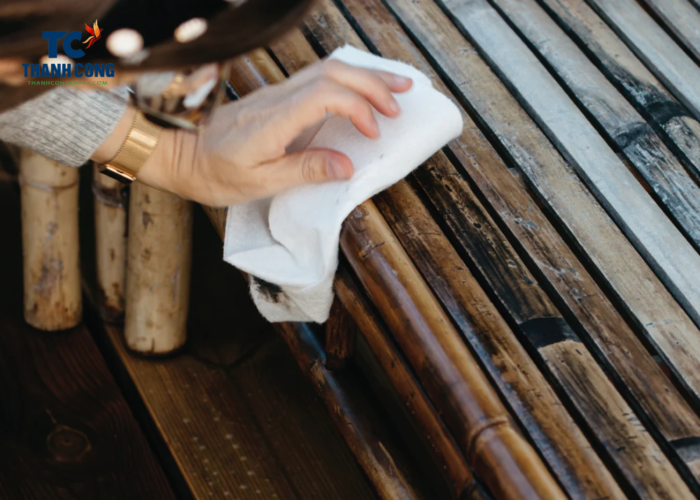
- Prevention of Mold and Mildew: Bamboo furniture is vulnerable to mold and mildew growth, especially in damp conditions. Oiling the bamboo helps inhibit the development of these fungi, preserving the furniture’s cleanliness and structural integrity.
- Enhanced Durability: The application of oil strengthens bamboo fibers, increasing the furniture’s overall durability. This protective layer minimizes the impact of daily wear and tear, prolonging the life of the furniture.
- Color Enhancement: Bamboo tends to fade over time due to exposure to sunlight and other environmental factors. Applying oil not only nourishes the bamboo but can also enhance and restore its natural color, providing a vibrant and refreshed appearance.
- Aesthetic Appeal: Oil can bring out the natural beauty of bamboo, highlighting its unique grain patterns and textures. This not only adds to the visual appeal of the furniture but also maintains its original charm.
- Maintenance of Flexibility: Bamboo is a flexible material, and over time, it can become brittle if not properly cared for. Regular oiling helps maintain the flexibility of bamboo, reducing the risk of cracks and breakage.
- Environmental Protection: Oiling bamboo furniture can act as a shield against outdoor elements, including exposure to UV rays. This protection prevents the bamboo from deteriorating, ensuring its eco-friendly qualities are maintained.
2. Best Oil for Bamboo Furnitures
When it comes to preserving and enhancing the beauty of your bamboo furniture, selecting the right oil is crucial. Here are some top contenders:
2.1 Tung Oil
Tung oil is renowned for its excellent penetrating qualities, providing a deep and durable finish and is a perfect oil for outdoor bamboo furniture. It enhances the natural colors and grain patterns of bamboo, offering a protective layer against moisture and wear.
How to Apply Tung Oil to Bamboo Furniture:
- Start by applying tung oil using a natural-bristled paintbrush. Brush it evenly onto the bamboo surface and allow it to penetrate. After a short period, typically 5-10 minutes, wipe off any excess oil using a soft cloth.
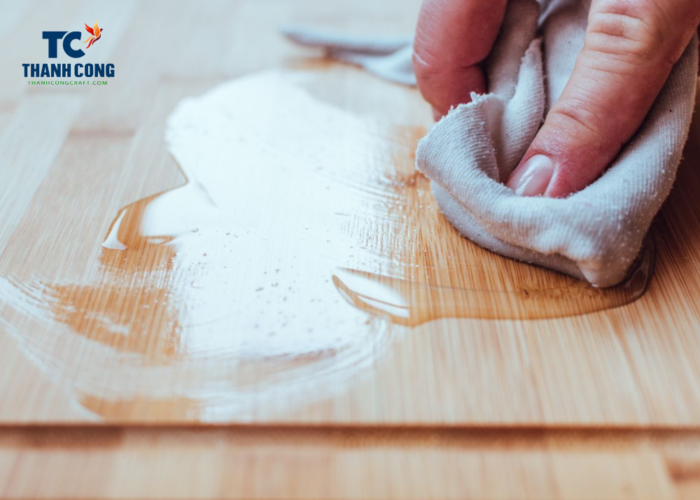
- Once the furniture is completely dry, address any surface imperfections by gently using 0000 grade steel wool. This step helps in achieving a smoother finish and ensures the tung oil is absorbed uniformly.
- For optimal results, repeat the brushing and wiping process (steps 1 and 2) 3-6 times or until you achieve the desired look and finish. This layering technique enhances the protective and aesthetic qualities of the tung oil.
- Apply tung oil to your bamboo furniture at least twice a year to maintain its protection and appearance. In areas with lower humidity or less exposure to extreme weather conditions, an annual application may suffice. Regular maintenance ensures the longevity and beauty of your bamboo furniture.
2.2 Linseed Oil
Linseed oil for bamboo furniture, obtained from flax seeds, remains a favored option. It enhances bamboo’s inherent warmth, effectively seeping in to safeguard the furniture against environmental factors, albeit with a slightly lengthier drying time when compared to alternative oils.
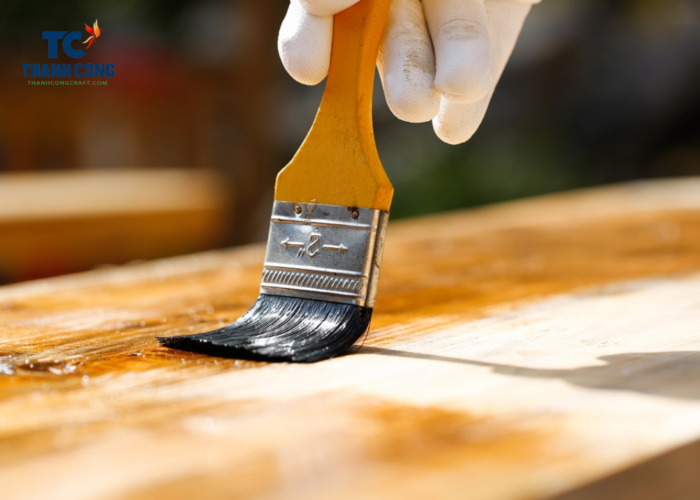
How to Apply Linseed Oil to Bamboo Furniture:
- Apply linseed oil onto the bamboo using a cloth. Rub it thoroughly into the surface, ensuring even coverage. This process helps the oil penetrate the bamboo fibers for effective protection and enhancement.
- For raw linseed oil, allow a minimum of 2-3 days between applications to ensure proper drying and absorption. If you are using boiled linseed oil, a 24-hour interval between applications should be sufficient. This waiting period allows the oil to be absorbed into the bamboo, contributing to a more durable finish.
- Once you achieve the desired finish and the bamboo has absorbed the oil adequately, buff the furniture with a soft cloth. This step not only enhances the sheen but also ensures a smooth and polished appearance.
2.3 Lemon Oil
Lemon oil is a lighter option, offering a fresh and citrusy scent along with effective cleaning properties. While it may not provide as robust a protective layer as some other oils, it’s a great choice for routine maintenance and adding a refreshing aroma to your bamboo pieces.
How to Apply Lemon Oil to Bamboo Furniture:
- Use a clean, soft cloth to apply lemon oil to the bamboo furniture. Pour a small amount of lemon oil onto the cloth or apply directly to the furniture surface. Start with a modest amount and add more as needed.
- Rub the lemon oil into the bamboo surface using a circular motion. Ensure even coverage, paying attention to any joints or crevices. Lemon oil not only adds a fresh scent but also nourishes and revitalizes the bamboo.
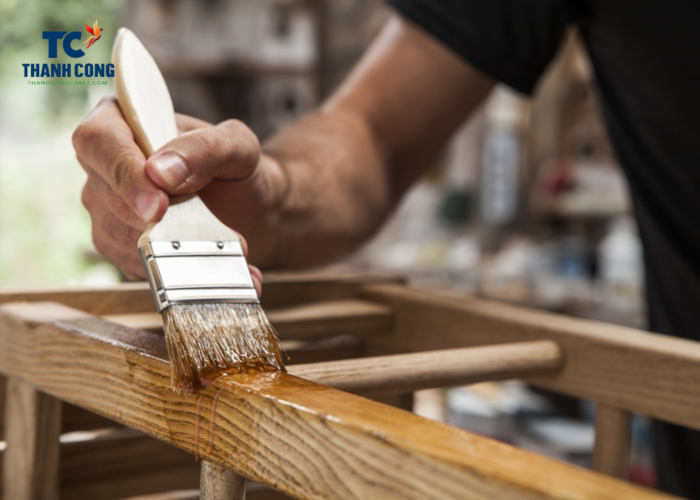
- Let the lemon oil sit on the bamboo for a few minutes to allow absorption. This allows the oil to penetrate the bamboo fibers, enhancing its natural luster and providing a protective layer.
- After allowing sufficient time for absorption, use a clean, dry cloth to wipe off any excess lemon oil. This step helps achieve a polished and non-greasy finish.
2.4 Teak Oil
To treat bamboo furniture for outdoor use, houe woca teak oil is a great choice. It not only enhances the natural beauty of the wood but also provides excellent protection against moisture and UV rays.
Teak oil is known for its quick drying time and durability that is a most perfect protective coating for bamboo furniture.
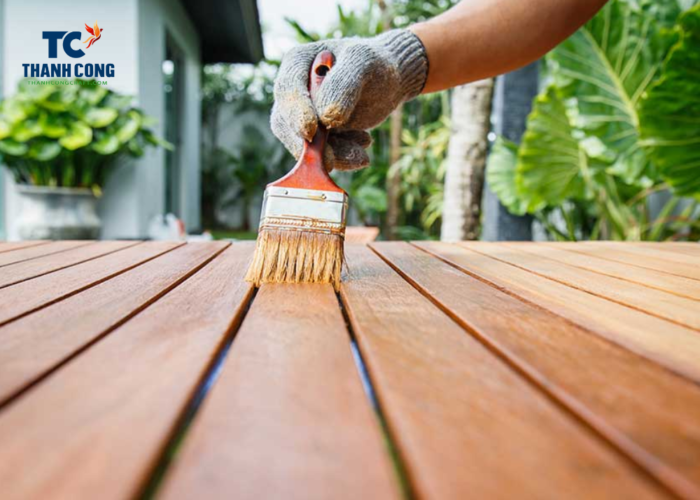
Process for Oiling Bamboo Furniture:
- Begin by gently cleaning the bamboo surface with only water and a soft brush. Allow it to air dry.
- Next, use a 200 or 240-grit sandpaper to sand the bamboo in the same direction as its natural grain. Remove any dust or residue.
- Apply the oil using a soft paintbrush. Start by carefully running the brush along the gaps between the lamellas, ensuring thorough coverage. Unlike stains, oil won’t create bubbles or drip lines.
- Once the gaps are properly oiled, proceed to the surface. Apply the oil generously to ensure even distribution, brushing it in the direction of the grain.
- Within 5 to 10 minutes of application, use a clean cloth to wipe off any excess oil from each lamella. Typically, three strokes per lamella will suffice.
- Allow the bamboo to dry for approximately 30 to 50 minutes.
2.5 Bamboo Furniture Varnish Vmb500
The Bamboo Furniture Varnish VMB500 offers optimal protection for bamboo interior furnishings, such as furniture, countertops, kitchen and bathroom fixtures, and kitchen surfaces. Its purpose is to enhance the resilience of bamboo against stains, impacts, scratches, and moisture.
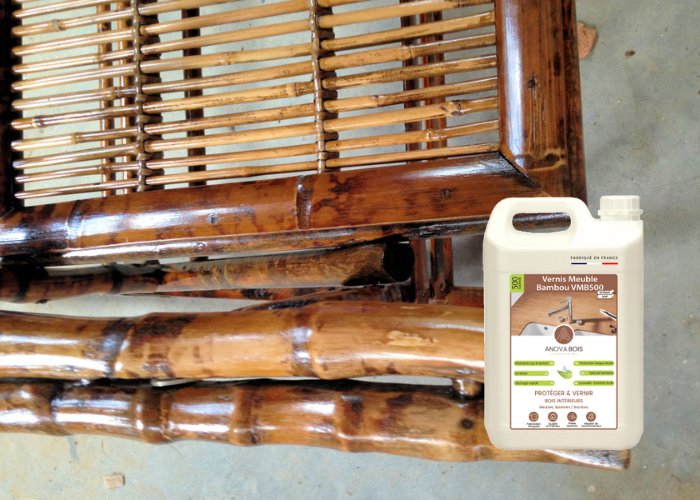
Process:
- Prepare your bamboo furniture
To apply bamboo furniture varnish VMB500 to bamboo furniture, ensure that the bamboo surface is clean, dry, devoid of dust, and free from any remnants of previous finishes.
If necessary, remove any old finishes by stripping or sanding until you reach the raw bamboo, and then meticulously remove any dust.
- Application of varnish
The varnish is ready to use; be sure to shake it well before applying it to your bamboo furniture or worktop.
For the best results when applying varnish to bamboo, ensure the following conditions: a temperature range of 18°C (64.4°F) to 25°C (77°F), and a dry environment with an air humidity level between 40% and 60%. Apply the varnish along the bamboo grain using a brush, spalter, or roller, ensuring two even and complete coats.
- Drying
Allow a minimum of 2 hours of drying time between each coat of bamboo varnish, but do not exceed 24 hours. It’s recommended to lightly sand the surface with fine sandpaper (120 grit) after the initial coat of varnish, and once again, remove any dust before applying the subsequent coat.
Full hardening of the varnish will occur over a few days, so exercise care during the initial curing period.
Choosing the best oil for bamboo furniture is an investment in timelessness. It’s about not just protection but a revelation of the bamboo’s unique grain, color, and texture. Choose wisely, care meticulously, and let the best oil become the timeless guardian of your bamboo furniture’s innate splendor.
If you have any further questions, don’t hesitate to send thanhcongcraft an email us at info@thanhcongcraft.com or message us at WhatsApp: +84967485411. Hope to serve you soon! Best regard!


